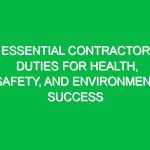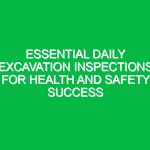Introduction
Hello team! Thank you for gathering here today for our Toolbox Talk. Today, we are going to focus on an essential aspect of our Health, Safety, and Environment (HSE) practices—**Situational Awareness**. This concept is critical in our daily operations and can significantly impact our Safety and the Safety of those around us. By enhancing our Situational Awareness, we can identify potential Hazards early, make informed decisions, and prevent accidents before they occur. Let’s dive into what Situational Awareness entails, why it’s important, and how we can improve it in our work environment.
What is Situational Awareness?
Situational Awareness refers to the understanding of what is happening around you at any given moment. In the HSE context, it means being aware of your environment, understanding the potential risks, and anticipating how changes in your surroundings can affect your safety and the safety of others. It involves three key components:
- Perception: Recognizing the relevant elements in your environment.
- Comprehension: Understanding the significance of those elements and how they interact.
- Projection: Anticipating future events based on the current situation.
By cultivating a high level of Situational Awareness, we can better navigate our work environment and respond effectively to changing circumstances.
Why is Situational Awareness Important?
Situational Awareness is crucial for several reasons:
- Accident Prevention: Many workplace accidents occur due to a lack of awareness. By being vigilant and observant, we can identify potential Hazards before they lead to incidents.
- Improved Decision-Making: With a clear understanding of our environment, we can make informed decisions that prioritize safety.
- Enhanced Communication: Situational Awareness allows us to communicate effectively with our colleagues, ensuring everyone is on the same page regarding safety protocols.
- Adapting to Change: Work environments can change rapidly. Being aware of these changes enables us to adapt quickly and maintain safety.
In essence, a strong sense of Situational Awareness is foundational to maintaining a safe workplace.
Components of Situational Awareness in HSE
Understanding the components of Situational Awareness can help us enhance our practices. Let’s break down these components further:
1. Perception
Perception involves recognizing key elements in our environment. This includes:
- Identifying potential hazards, such as moving machinery, electrical equipment, or chemicals.
- Observing the behavior of coworkers and understanding their actions.
- Noticing environmental changes, like weather conditions or changes in terrain.
An example of perception in action could be noticing that a coworker is not wearing their Personal Protective Equipment (PPE). This observation could lead to a conversation about safety protocols, potentially preventing an injury.
2. Comprehension
Comprehension goes beyond mere observation; it involves understanding what those observations mean. To improve comprehension:
- Ask yourself: What hazards are present? How do they interact with my current tasks?
- Share insights with your team. If you notice a potential risk, discuss it openly.
- Stay informed about the safety data sheets (SDS) relevant to the substances you’re working with.
For instance, understanding that a wet floor increases the risk of slipping allows us to take immediate action, such as placing warning signs or cleaning up the spill.
3. Projection
Projection is about anticipating future outcomes based on your current understanding. Consider these strategies:
- Envision potential scenarios based on your observations. What could happen if a certain hazard is left unaddressed?
- Think ahead about how changes in the environment may affect your work. For example, if a storm is approaching, what Safety Measures should be implemented?
- Encourage your coworkers to think critically about potential risks during Toolbox Talks.
By practicing projection, we can prepare for and mitigate risks before they escalate.
Real-Life Examples of Situational Awareness
Let’s look at some real-life scenarios where Situational Awareness played a crucial role in safety:
Scenario 1: Construction Site
Imagine a construction site where a worker is operating heavy machinery. They notice that a colleague is standing too close to the equipment. By being aware of this situation, the operator can stop the machine and alert their coworker, preventing a potentially serious accident. This demonstrates how awareness of others can directly influence safety.
Scenario 2: Chemical Spill
In a laboratory setting, a worker accidentally spills a chemical. By quickly recognizing the need to contain the spill and alerting others, they prevent exposure and ensure proper cleanup protocols are followed. This situation illustrates the importance of quick thinking and effective communication in maintaining safety.
Best Practices for Enhancing Situational Awareness
Now that we’ve discussed the importance of Situational Awareness and its components, let’s explore some Best Practices to enhance it in our daily operations:
- Stay Engaged: Always be present in the moment. Avoid distractions such as phones or conversations that can detract from your awareness.
- Conduct Regular Safety Checks: Take moments throughout your shift to assess your environment. Are there any new hazards? Are safety protocols being followed?
- Communicate Effectively: Foster an open environment where everyone feels comfortable discussing safety. If you notice something concerning, speak up!
- Participate in Training: Attend HSE training sessions to reinforce your knowledge of hazards and safety protocols.
- Practice Mindfulness: Techniques such as deep breathing can help improve focus and reduce stress, allowing for better situational awareness.
Implementing these practices can help us develop a culture of safety where everyone contributes to maintaining a secure work environment.
Potential Hazards Related to Situational Awareness
While enhancing Situational Awareness is important, we must also recognize the potential hazards that may arise if we are not aware. Here are some risks to consider:
- Distraction: In our fast-paced work environment, distractions can lead to missed hazards. Always prioritize safety over multitasking.
- Fatigue: Tiredness can impair our ability to perceive and comprehend our surroundings. Encourage breaks to maintain alertness.
- Complacency: Over-familiarity with tasks can dull our sense of awareness. Regularly re-evaluate your surroundings, even in familiar situations.
Recognizing these hazards can help us remain vigilant and proactive in our safety practices.
Regulations and Standards
In the realm of HSE, several Regulations and standards underscore the importance of Situational Awareness. For instance:
- Occupational Safety and Health Administration (OSHA): osha regulations emphasize the responsibility of employers to maintain a safe workplace, which includes fostering a culture of Situational Awareness.
- ISO 45001: This international standard for Occupational Health and safety management systems highlights the importance of risk assessment and situational awareness in preventing workplace incidents.
Compliance with these regulations not only protects employees but also helps organizations avoid legal repercussions and enhance their reputation.
Conclusion
In closing, enhancing our Situational Awareness is vital for maintaining a safe and efficient workplace. By understanding what Situational Awareness is, why it’s important, and how to improve it, we can significantly reduce the risk of accidents and injuries. Remember to stay engaged, communicate openly, and regularly assess your surroundings. Your commitment to safety and awareness is crucial in creating a secure work environment for everyone.
Thank you for your attention today. Let’s make a collective effort to apply these principles in our daily operations. Now, I’d like to open the floor for any questions or discussions you might have about Situational Awareness or any safety concerns you’d like to address. Together, we can enhance our safety culture and ensure that we all return home safely at the end of each day.


